TATAU: THE TAHITIAN REVIVAL
by Tricia Allen
All Tattoo images on this page by Tahitian tattooer Po’oino Yrondi
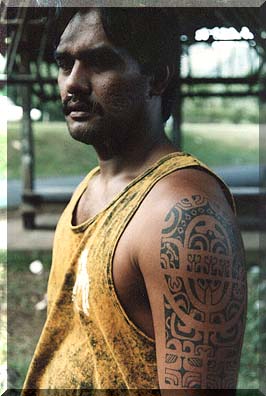 Tattooing was an integral part of ancient Tahitian society. It was far more than merely a bodily ornament. Tattoos would indicate a young girl’s sexual maturity, freedom from food tapus and other restrictions, genealogy and one’s rank within society. Nearly everyone in ancient Tahitian society was tattooed. The early French explorer Bougainville noted that “the women of Tahiti dye their loins and buttocks a deep blue” and Captain Cook returned from the Pacific with stories of the art of tatau (hence, the origin of the word tattoo). Shortly after the missionaries arrival the practice was strictly banned, as it was viewed it as a sinful glorification of the flesh. In recent years, however, the art of tattooing has enjoyed a renaissance. Tahitians, and other Polynesians as well, are once again taking pride and interest in their cultural heritage, finding their identity in the revival of many lost arts–including the traditional tatau.
Tattooing was an integral part of ancient Tahitian society. It was far more than merely a bodily ornament. Tattoos would indicate a young girl’s sexual maturity, freedom from food tapus and other restrictions, genealogy and one’s rank within society. Nearly everyone in ancient Tahitian society was tattooed. The early French explorer Bougainville noted that “the women of Tahiti dye their loins and buttocks a deep blue” and Captain Cook returned from the Pacific with stories of the art of tatau (hence, the origin of the word tattoo). Shortly after the missionaries arrival the practice was strictly banned, as it was viewed it as a sinful glorification of the flesh. In recent years, however, the art of tattooing has enjoyed a renaissance. Tahitians, and other Polynesians as well, are once again taking pride and interest in their cultural heritage, finding their identity in the revival of many lost arts–including the traditional tatau.
The revival of ttraditional tattoo in Tahiti began in 1981 when Tavana, a previous resident of Hawai’i and Waikiki nightclub owner, and a young Marquesan dancer named Teve, went to Germany to research traditional tattoo designs. On their return trip they stopped in Samoa, as Samoa is the only island group within Polynesia that kept the art of the traditional tatau alive. Arrangements were made for a Samoan tattooist to visit Tahiti, where Teve would receive the full-body traditional tatau done in the Marquesan style, and Tavana would be tattooed with Tahitian designs.
 Both Teve and Tavana were tattooed using traditional Samoan tools techniques. Teve’s design was copied from one of the earliest records of Marquesan tattooing, an illustration from the journals of Krusenstern, a Captain on the first Russian voyage around the world in 1803-5. Tavana’s tattoos were inspired by the descriptions and illustrations of Tahitian tattooing recorded by the early observers. Through Tavana’s efforts in bringing the Samoan tattooist to Tahiti, the traditional tattoo was reintroduced into Tahitian culture. In 1982 at the annual Baistille Day festivities in Tahiti, three Samoans demonstrated traditional tattooing. Having seen the Samoan technique, several Tahitian artists were able construct tools and revive the Tahitian form of the art. In 1983-5 there were two demostrations at the fete; the Samoans demonstrating their style and three Tahitians who had learned the art of traditional tatau.
Both Teve and Tavana were tattooed using traditional Samoan tools techniques. Teve’s design was copied from one of the earliest records of Marquesan tattooing, an illustration from the journals of Krusenstern, a Captain on the first Russian voyage around the world in 1803-5. Tavana’s tattoos were inspired by the descriptions and illustrations of Tahitian tattooing recorded by the early observers. Through Tavana’s efforts in bringing the Samoan tattooist to Tahiti, the traditional tattoo was reintroduced into Tahitian culture. In 1982 at the annual Baistille Day festivities in Tahiti, three Samoans demonstrated traditional tattooing. Having seen the Samoan technique, several Tahitian artists were able construct tools and revive the Tahitian form of the art. In 1983-5 there were two demostrations at the fete; the Samoans demonstrating their style and three Tahitians who had learned the art of traditional tatau.
 The tatatau, or traditional tattooing tools, consist of a comb with anywhere from three to twenty needles carved from bone and/or shell and hafted to a wooden handle, giving the general shape of an adze. The needles are dipped into a pigment made from the soot of burnt candlenut (tiairi) mixed with water or oil. The needles are then placed on the skin and the handle is tapped with a second wooden stick, causing the comb to puncture the skin and insert the pigment.
The tatatau, or traditional tattooing tools, consist of a comb with anywhere from three to twenty needles carved from bone and/or shell and hafted to a wooden handle, giving the general shape of an adze. The needles are dipped into a pigment made from the soot of burnt candlenut (tiairi) mixed with water or oil. The needles are then placed on the skin and the handle is tapped with a second wooden stick, causing the comb to puncture the skin and insert the pigment.
Tatau, or tattooing with traditional tools, was banned in 1986 by the Ministry of Health due to the difficulty in sterilizing the wooden and bone equipment. In order to continue practicing the art, the artists developed a tattoo machine constructed from an electric shaver that utilized disposable steel needles, thus avoiding any risk of spreading disease. In recent years, tattooing has become increasingly popular amoung young Tahitians. Dozens of artists are now giving tattoos using shaver-type machines and semi-traditional designs. The traditional tattoo technique and tools were much the same throughout most of the islands in the Pacific; it was the social significance, the designs, and body placement that varied greatly. Our knowledge of Tahitian tattooing in pre-contact times is quite limited. There are only a dozen or so descriptions of the art and even fewer illustrations. We do know that it was a tapu or “sacred” art form. It was performed by skilled professionals who were highly trained in the ritual, aesthetic and technical aspects of the art. Both the designs applied and the location on the body were determined by one’s genealolgy, position within the society and personal achievements. Although much of this knowledge has been lost, several contemporary artists are studying the old texts, illustrations and their family records in order to learn what they can of the ancient practice, while other artists are now focusing primarily on visual aspects, creating new designs based on the traditional motifs of both Tahiti and the Marquesas.







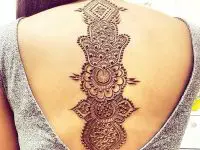
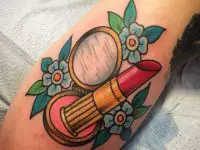


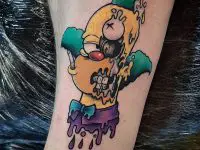
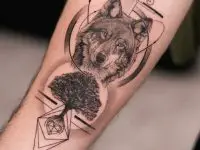
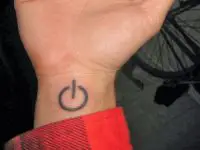


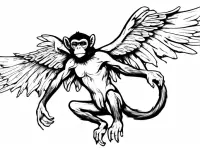
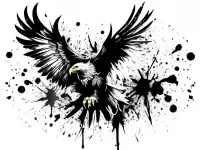
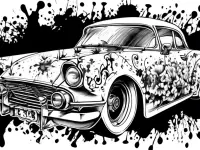


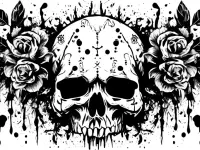


0 Comments